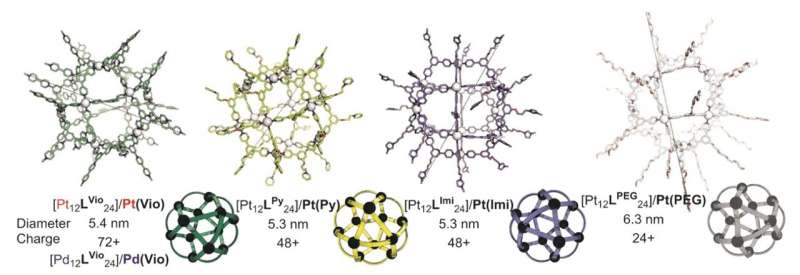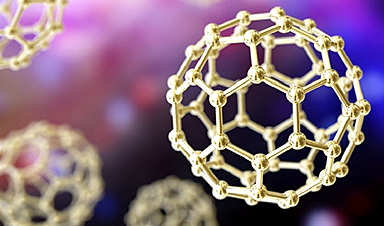Small interfering RNAs (siRNAs) are novel therapeutics that can be used to treat a wide range of diseases. This has led to a growing demand for selective, efficient, and safe ways of delivering siRNA in cells. Now, in a cooperation between the Universities of Amsterdam and Leiden, researchers have developed dedicated molecular nanocages for siRNA delivery. In a paper just out in the journal Chem they present nanocages that are easy to prepare and display tunable siRNA delivery characteristics.
The researchers were motivated by the potential of siRNA in gene therapy, which requires the need for effective delivery systems. They set out to develop nanocages with functional groups at the outside, making the cages capable of binding siRNA strands. As the binding is based on reversible bonds, the siRNA can in principle be released in a cellular environment. To explore the delivery characteristics of their nanocages, the researchers performed a laboratory study using various human cancer cells.
A range of nanocages
The nanocages are constructions of small molecular building blocks, so-called ditopic ligands, that are connected using metal atoms. A typical cage consists of 12 metal atoms and 24 ligands, hence the abbreviation M12L24. The researchers designed and synthesized five different ligands to form molecular cages with different siRNA binding affinities. They then prepared a range of siRNA binding nanocages using platinum or palladium as connecting metal. The palladium nanocages are less stable in a cellular environment, and decomposition is one of the siRNA releasing mechanisms.

After screening nanocage characteristics such as stability and siRNA binding capability, the delivery characteristics were put to the test in assays based on siRNA-mediated Green Fluorescent Protein (GFP) silencing. The cages were used to deliver siRNA to human GFP-expressing cells, so that fluorescence measurements could establish successful siRNA delivery. Two types of human cell lines were used: HeLa and U2Os.
Cage composition determines siRNA delivery
To their surprise, the researchers could not only demonstrate satisfying siRNA delivery, but also discovered a remarkable differentiation depending on the metal used in the nanocage. Where a platinum-based Pt12L24 nanocage showed highly effective siRNA delivery to U2OS cells, it showed little efficiency for HeLa. By contrast, the palladium-based Pd12L24 nanocage, derived from the same ligand building block, delivered siRNA to HeLa but not to U2OS. Such differentiation could not be observed in experiments were a commercially applied delivery system (lipofectamine) was used. The M12L24 nanocages thus introduce the possibility of tuning siRNA delivery characteristics by tuning the nanocage composition.
News
Repurposed drugs could calm the immune system’s response to nanomedicine
An international study led by researchers at the University of Colorado Anschutz Medical Campus has identified a promising strategy to enhance the safety of nanomedicines, advanced therapies often used in cancer and vaccine treatments, [...]
Nano-Enhanced Hydrogel Strategies for Cartilage Repair
A recent article in Engineering describes the development of a protein-based nanocomposite hydrogel designed to deliver two therapeutic agents—dexamethasone (Dex) and kartogenin (KGN)—to support cartilage repair. The hydrogel is engineered to modulate immune responses and promote [...]
New Cancer Drug Blocks Tumors Without Debilitating Side Effects
A new drug targets RAS-PI3Kα pathways without harmful side effects. It was developed using high-performance computing and AI. A new cancer drug candidate, developed through a collaboration between Lawrence Livermore National Laboratory (LLNL), BridgeBio Oncology [...]
Scientists Are Pretty Close to Replicating the First Thing That Ever Lived
For 400 million years, a leading hypothesis claims, Earth was an “RNA World,” meaning that life must’ve first replicated from RNA before the arrival of proteins and DNA. Unfortunately, scientists have failed to find [...]
Why ‘Peniaphobia’ Is Exploding Among Young People (And Why We Should Be Concerned)
An insidious illness is taking hold among a growing proportion of young people. Little known to the general public, peniaphobia—the fear of becoming poor—is gaining ground among teens and young adults. Discover the causes [...]
Team finds flawed data in recent study relevant to coronavirus antiviral development
The COVID pandemic illustrated how urgently we need antiviral medications capable of treating coronavirus infections. To aid this effort, researchers quickly homed in on part of SARS-CoV-2's molecular structure known as the NiRAN domain—an [...]
Drug-Coated Neural Implants Reduce Immune Rejection
Summary: A new study shows that coating neural prosthetic implants with the anti-inflammatory drug dexamethasone helps reduce the body’s immune response and scar tissue formation. This strategy enhances the long-term performance and stability of electrodes [...]
Scientists discover cancer-fighting bacteria that ‘soak up’ forever chemicals in the body
A family of healthy bacteria may help 'soak up' toxic forever chemicals in the body, warding off their cancerous effects. Forever chemicals, also known as PFAS (per- and polyfluoroalkyl substances), are toxic chemicals that [...]
Johns Hopkins Researchers Uncover a New Way To Kill Cancer Cells
A new study reveals that blocking ribosomal RNA production rewires cancer cell behavior and could help treat genetically unstable tumors. Researchers at the Johns Hopkins Kimmel Cancer Center and the Department of Radiation Oncology and Molecular [...]
AI matches doctors in mapping lung tumors for radiation therapy
In radiation therapy, precision can save lives. Oncologists must carefully map the size and location of a tumor before delivering high-dose radiation to destroy cancer cells while sparing healthy tissue. But this process, called [...]
Scientists Finally “See” Key Protein That Controls Inflammation
Researchers used advanced microscopy to uncover important protein structures. For the first time, two important protein structures in the human body are being visualized, thanks in part to cutting-edge technology at the University of [...]
AI tool detects 9 types of dementia from a single brain scan
Mayo Clinic researchers have developed a new artificial intelligence (AI) tool that helps clinicians identify brain activity patterns linked to nine types of dementia, including Alzheimer's disease, using a single, widely available scan—a transformative [...]
Is plastic packaging putting more than just food on your plate?
New research reveals that common food packaging and utensils can shed microscopic plastics into our food, prompting urgent calls for stricter testing and updated regulations to protect public health. Beyond microplastics: The analysis intentionally [...]
Aging Spreads Through the Bloodstream
Summary: New research reveals that aging isn’t just a local cellular process—it can spread throughout the body via the bloodstream. A redox-sensitive protein called ReHMGB1, secreted by senescent cells, was found to trigger aging features [...]
AI and nanomedicine find rare biomarkers for prostrate cancer and atherosclerosis
Imagine a stadium packed with 75,000 fans, all wearing green and white jerseys—except one person in a solid green shirt. Finding that person would be tough. That's how hard it is for scientists to [...]
Are Pesticides Breeding the Next Pandemic? Experts Warn of Fungal Superbugs
Fungicides used in agriculture have been linked to an increase in resistance to antifungal drugs in both humans and animals. Fungal infections are on the rise, and two UC Davis infectious disease experts, Dr. George Thompson [...]





















